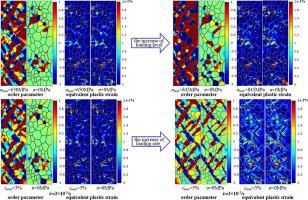当前位置:
X-MOL 学术
›
Comp. Mater. Sci.
›
论文详情
Our official English website, www.x-mol.net, welcomes your
feedback! (Note: you will need to create a separate account there.)
Phase-field theory based finite element simulation on thermo-mechanical cyclic deformation of polycrystalline super-elastic NiTi shape memory alloy
Computational Materials Science ( IF 3.1 ) Pub Date : 2020-11-01 , DOI: 10.1016/j.commatsci.2020.109899 Xi Xie , Guozheng Kang , Qianhua Kan , Chao Yu
Computational Materials Science ( IF 3.1 ) Pub Date : 2020-11-01 , DOI: 10.1016/j.commatsci.2020.109899 Xi Xie , Guozheng Kang , Qianhua Kan , Chao Yu

|
Abstract Based on the previously developed isothermal phase field model [1], the thermo-mechanical cyclic deformation of polycrystalline super-elastic NiTi shape memory alloy (SMA) was simulated by a newly proposed thermo-mechanical phase filed based finite element method. To ensure the efficiency of numerical simulation, a two-dimensional (2D) phase field based finite element method was proposed. From the simulations, it is concluded that the cyclic super-elasticity degradation and related phase transition mode of polycrystalline NiTi SMA and their dependence on the loading rate and loading level are reasonably modeled. Furthermore, correspondent physical mechanism is summarized, that is, the cyclic degradation of super-elasticity and the localization of phase transition (especially for that in the stable cycle) become more significant by increasing loading level and loading rate, but the physical mechanisms of them are different: they are attributed to the increase of residual martensite bands resulted from the expansion of relatively large plastic deformation domain in the polycrystalline NiTi SMA if increasing the loading level; while, if increasing the loading rate, they are attributed to the increase of residual martensite bands resulted from the impediment of thermo-mechanical coupled effect to the phase transition.
中文翻译:

基于相场理论的多晶超弹性镍钛形状记忆合金热机械循环变形有限元模拟
摘要 基于先前开发的等温相场模型[1],采用新提出的基于热机械相场的有限元方法模拟了多晶超弹性NiTi形状记忆合金(SMA)的热机械循环变形。为保证数值模拟的效率,提出了一种基于二维(2D)相场的有限元方法。从模拟结果可以得出结论,多晶 NiTi SMA 的循环超弹性退化和相关相变模式及其对加载速率和加载水平的依赖性被合理建模。此外,总结了相应的物理机制,即 随着加载水平和加载速率的增加,超弹性的循环退化和相变的局部化(特别是在稳定循环中)变得更加显着,但它们的物理机制不同:它们归因于残余物的增加如果增加加载水平,马氏体带是由多晶NiTi SMA中相对较大的塑性变形域的扩展引起的;而如果增加加载速率,则归因于热-机械耦合效应阻碍相变导致残余马氏体带的增加。它们归因于如果增加加载水平,多晶NiTi SMA中相对较大的塑性变形域的扩展导致残余马氏体带的增加; 而如果增加加载速率,则归因于热-机械耦合效应阻碍相变导致残余马氏体带的增加。它们归因于如果增加加载水平,多晶NiTi SMA中相对较大的塑性变形域的扩展导致残余马氏体带的增加; 而如果增加加载速率,则归因于热-机械耦合效应对相变的阻碍导致残余马氏体带的增加。
更新日期:2020-11-01
中文翻译:

基于相场理论的多晶超弹性镍钛形状记忆合金热机械循环变形有限元模拟
摘要 基于先前开发的等温相场模型[1],采用新提出的基于热机械相场的有限元方法模拟了多晶超弹性NiTi形状记忆合金(SMA)的热机械循环变形。为保证数值模拟的效率,提出了一种基于二维(2D)相场的有限元方法。从模拟结果可以得出结论,多晶 NiTi SMA 的循环超弹性退化和相关相变模式及其对加载速率和加载水平的依赖性被合理建模。此外,总结了相应的物理机制,即 随着加载水平和加载速率的增加,超弹性的循环退化和相变的局部化(特别是在稳定循环中)变得更加显着,但它们的物理机制不同:它们归因于残余物的增加如果增加加载水平,马氏体带是由多晶NiTi SMA中相对较大的塑性变形域的扩展引起的;而如果增加加载速率,则归因于热-机械耦合效应阻碍相变导致残余马氏体带的增加。它们归因于如果增加加载水平,多晶NiTi SMA中相对较大的塑性变形域的扩展导致残余马氏体带的增加; 而如果增加加载速率,则归因于热-机械耦合效应阻碍相变导致残余马氏体带的增加。它们归因于如果增加加载水平,多晶NiTi SMA中相对较大的塑性变形域的扩展导致残余马氏体带的增加; 而如果增加加载速率,则归因于热-机械耦合效应对相变的阻碍导致残余马氏体带的增加。











































 京公网安备 11010802027423号
京公网安备 11010802027423号